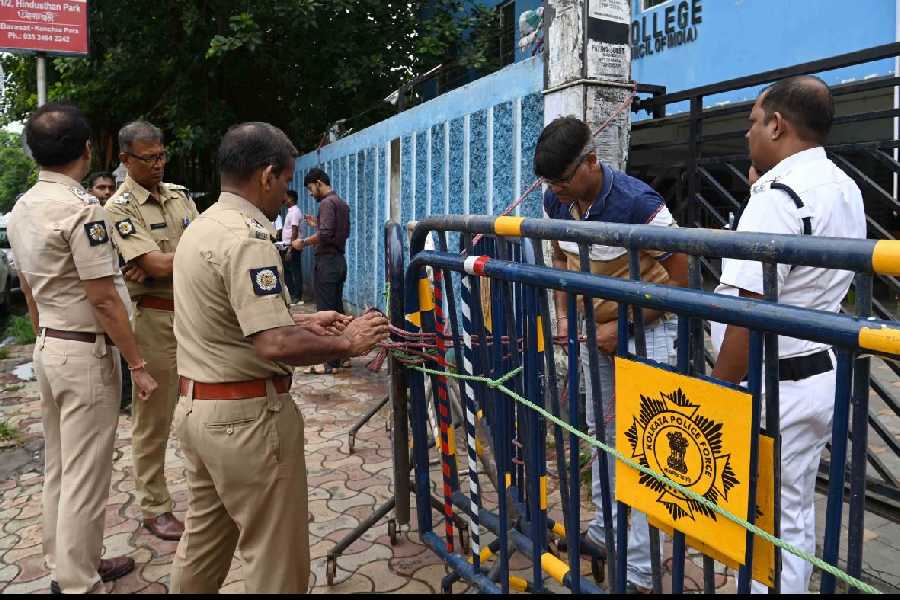 |
| Artist Jocelyn Galsworthy painted Panesar bowling to Sehwag in Mumbai |
London, Nov. 25: Yesterday’s Daily Telegraph had an innovation: it didn’t use a photograph to show Monty Panesar bowling to Virender Sehwag in the Mumbai Test.
Instead, it used a rather evocative watercolour by the British artist Jocelyn Galsworthy.
The Daily Telegraph was making the point that because of a deepening dispute between the Indian cricket board and two UK picture agencies, Getty Images and Action Images, British newspapers are not using any photos from the current Test series. Certainly not the few insipid ones supplied free of charge by the Board of Control for Cricket in India (BCCI).
But if the paintings are anywhere as good as the one published yesterday, there is a real danger that the readers won’t miss the run-of-the-mill sports photos.
“Galsworthy is well known for her highly acclaimed paintings of English and international cricket and is often seen in her white hat, sitting on the boundary, recording a day’s play for posterity,” The Daily Telegraph added.
On other days, the paper had been carrying cartoons depicting play in an effort to entertain its readers and simultaneously humiliate the BCCI. The Times, London, The Daily Mail and other UK newspapers have joined the protest.
So have international news agencies such as Reuters — with which Action Images has business links — AFP and AP, which are not banned but have decided to express solidarity with Getty and Action. None of them is clicking photos, providing match reports or even attending the pre- or post-match news conferences.
Reuters said the BCCI’s new policy “unfairly discriminate(s) against genuine editorial news agencies, including Action Images, a Thomson Reuters business”. Getty had received BCCI accreditation in previous years.
BCCI stand
BCCI secretary Sanjay Jagdale has justified refusing accreditation to some “international and domestic applicants” for “photographic coverage” of the series.
“Their primary businesses involved the commercial sale and licensing of images rather than the supply of images to news publications for bona fide editorial purposes,” he explained in a release.
“The BCCI stands by its decision, which is based on the legitimate interest of prioritising and limiting stadium access to those persons and entities primarily involved in news reporting.”
“Commercial sale” presumably refers to the use of the pictures in advertising, promotion of products, billboards, films, TV documentaries, books and the like. These can bring in fees and Getty’s assumption is that the BCCI wants a cut.
The board, however, hasn’t asked for any fee so far from any news agency for accreditation. Nor has it objected to the agencies supplying pictures to Internet sites.
Ken Mainardis, senior director of editorial services at Getty Images, told The Telegraph that Getty was just like AFP, Reuters or any of the editorial agencies whose accreditation had been approved.
The BCCI’s rules already provide guarantees that the images would not be used for purposes other than editorial, he said. “We don’t understand the BCCI.”
Cricket Australia had tried to impose restrictions on agency photographers a few years ago but had to back off in the face of criticism. But the BCCI, the world’s richest and most powerful cricket board, is used to having its own way and isn’t averse to strong-arm tactics.
Moral muddles
The British media have perched their propaganda heavy guns on the moral high ground. However, a small note for readers that The Times, London, carried explaining the boycott inadvertently raised a moral question. It said: “To see the full article you need to subscribe.”
The newspaper seemed to have missed the slight irony of fighting for free press access by publishing text or photographs that the readers would be unable to access unless they took out subscriptions.
So, if The Times, London, wants money for people to read its online edition and look at photographs from the Tests in India, what is morally wrong with the BCCI wanting to flog the same images?
Once, in what many cricket lovers think were “the good old days”, Test match coverage was free on BBC television. But then the England and Wales Cricket Board (ECB) sold the rights for a hefty sum to Rupert Murdoch’s BSkyB, which is a subscription channel. The ECB profits from Test coverage but points out that the money it receives is ploughed back into the game.
All about money
The BCCI clearly wants to make as much hard currency as possible from its British visitors. It wanted £50,000 from the BBC for facilitating ball-by-ball radio commentary on Test Match Special. The BBC has agreed to this fee — a trifling sum compared with the £450,000 plus other perks it is giving George Entwistle for stepping down quietly as director-general after only 54 days in the job.
Rupert Murdoch’s Sky TV refused to meet the BCCI’s demand for an extra £500,000 for the privilege of covering the Tests.
Sky’s presenters, Nasser Hussain and Sir Ian Botham, are based in a studio in west London, where they superimpose their commentary on live feed from India’s STAR TV. The third presenter, Michael Atherton, who is also the correspondent of The Times, London, is in Mumbai and pops out of the stadium to do daily pieces before the cameras.
Getty and the boycotting agencies and newspapers are part of the London-based News Media Coalition, which focuses on “specific threat to legitimate editorial, press and publishing freedoms from the controls placed on news-gathering and news-distribution practices by the organisers of major events of public interest”.
The Coalition has questioned Jagdale’s claim that because of the boycott, the BCCI was providing “a limited number of images from each day’s play to all accredited media for their editorial use”.
“It appears to us that the BCCI was announcing plans to sell or give away its own photographs 10 days before the first Test and a week before international news agencies decided to suspend coverage,” said an email sent to this newspaper by the Coalition’s executive director, Andrew Moger.
“The BCCI’s latest justification implies it put this in place after coverage was withdrawn. At best the BCCI seems rather confused.”










